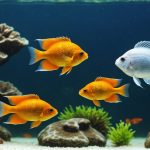Adding new fish to your aquarium can be exciting, but it also poses risks to your existing aquatic life. Quarantining new arrivals ensures that potential diseases are contained, protecting your entire ecosystem. This essential process helps you maintain water quality, avoid costly fish losses, and foster a thriving underwater community. Discover the practical steps to set up a quarantine system that keeps both your new fish and current inhabitants healthy and happy. Your aquarium's long-term wellbeing starts with a solid quarantine strategy.
Importance of Quarantine for New Fish
Understanding the importance of quarantine for new fish is crucial for maintaining a healthy aquarium environment. Quarantining new fish involves isolating them in a separate tank for a set period before introducing them to the main aquarium. This process is vital for disease prevention and ensuring aquarium health.
A lire également : Enhancing Habitats to Attract British Otters: Vital Improvements for Their Presence
A key benefit of quarantining new fish is the reduction of disease transmission. New fish might carry parasites or infections that can spread rapidly in your aquarium. By quarantining, you can monitor and treat any health issues without affecting the existing fish population. This proactive approach significantly enhances the overall aquarium health.
Failure to quarantine can lead to severe consequences. Introducing new fish without proper quarantine increases the risk of spreading diseases, which can lead to widespread illness or even death among fish. The costs of treating an infected aquarium can be substantial, both financially and emotionally.
A découvrir également : Discovering Cutting-Edge Therapies for Chronic Kidney Disease in Senior Cats: A Guide to the Latest Treatments
Consider these essential steps in the quarantine process:
- Set up a separate tank with appropriate filtration and temperature.
- Observe new fish for signs of illness for at least two weeks.
- Treat any detected diseases before introducing fish to the main tank.
By prioritizing fish quarantine importance, you ensure a thriving and healthy aquatic environment.
Step-by-Step Quarantine Process
Understanding the proper procedures for setting up a quarantine tank is essential for new fish introduction.
Setting Up a Quarantine Tank
A dedicated quarantine tank is your first line of defense. Ensure it has proper filtration and temperature control. Use a tank size suitable for the number and size of fish. Maintain clean water conditions to reduce stress and prevent the spread of disease.
Checklist for a Quarantine Tank:
- Appropriate filtration system
- Heater for stable temperature
- Basic lighting
- Hiding places for fish comfort
Acclimating New Fish
Gradual acclimation is crucial. Begin by floating the fish bag in the quarantine tank to equalize temperatures. Slowly introduce tank water into the bag over 30 minutes. This helps fish adjust to new water conditions, reducing shock and stress.
Duration of Quarantine
Monitor new fish for at least two weeks. Look for signs of illness, such as unusual swimming patterns or discoloration. Address any health issues promptly. This duration allows for effective observation and treatment, ensuring the safe introduction of fish to the main tank.
By following these quarantine steps, you protect your aquarium's health and foster a thriving aquatic environment. Prioritizing proper procedures is key to successful fish introduction.
Necessary Equipment and Conditions
Understanding the essentials of a successful quarantine setup is vital for effective fish care.
Essential Equipment for a Quarantine Tank
To ensure optimal fish care during quarantine, specific equipment is necessary. A quarantine tank should include:
- Filtration System: Keeps water clean and reduces stress.
- Heater: Maintains stable temperature, crucial for fish health.
- Lighting: Basic lighting helps observe fish condition.
- Hiding Places: Provides comfort and reduces stress.
Optimal Water Parameters for Quarantined Fish
Maintaining the right water parameters is critical. Ensure pH levels, temperature, and ammonia levels are within safe ranges. Regular checks and adjustments are necessary to provide a stable environment.
| Parameter | Ideal Range |
|---|---|
| Temperature | 24-26°C (75-79°F) |
| pH Level | 6.5-7.5 |
| Ammonia | 0 ppm |
Maintaining a Stable Environment During Quarantine
A stable environment is key to successful fish care. Regularly monitor water parameters and equipment functionality. Consistent conditions help prevent stress and disease, ensuring the health of quarantined fish. Adjustments should be made promptly to address any deviations.
By equipping and maintaining your quarantine tank properly, you safeguard the health of new fish, enabling a smooth transition into the main aquarium.
Common Fish Diseases and Treatments
Understanding common fish diseases is crucial for effective quarantine and maintaining aquarium health.
Overview of Common Diseases
New fish are susceptible to several diseases. Ichthyophthirius multifiliis, or "Ich," presents as white spots on fish. Fin Rot causes frayed fins and is often due to poor water quality. Velvet Disease gives fish a gold dust appearance and is caused by a parasitic infection.
Treatment Options for Quarantine Scenarios
Addressing fish diseases promptly in quarantine is essential. Ich can be treated with increased water temperature and medication. Fin Rot often requires antibacterial treatments and improved water conditions. For Velvet Disease, use copper-based medications following careful dosage instructions.
Treatment Checklist:
- Identify symptoms early
- Use appropriate medications
- Adjust water conditions as needed
Importance of Monitoring Fish Health
Regular health monitoring during quarantine allows for early detection of fish diseases. Observing behavior changes and physical symptoms helps in timely intervention. Implementing a daily check routine ensures that any signs of disease are addressed swiftly, preventing escalation.
By understanding and addressing these fish diseases through effective treatment options, you ensure a healthier environment for your aquatic life. Prioritizing health monitoring during quarantine is key to successful fish care.
Tips for Successful Fish Quarantine
Mastering the art of fish quarantine ensures a healthy aquarium environment.
Best Practices for Maintaining a Quarantine Tank
Quarantine Best Practices are essential for effective fish care. Ensure your quarantine tank is well-equipped with a reliable filtration system and heater. Regularly test water parameters to maintain optimal conditions. Keep the tank clean to prevent stress and disease.
Checklist for Tank Maintenance:
- Weekly water changes
- Daily parameter checks
- Equipment inspections
Tips for Observing Fish Behavior and Health
Observing fish behavior is crucial for health management. Pay attention to changes such as lethargy or unusual swimming patterns. These can indicate stress or disease. Use a journal to track observations and treatments. Early detection is key to successful health management.
Recommendations for Integrating Fish into the Main Aquarium
When integrating fish into the main aquarium, gradual acclimation is vital. Transfer fish during a time of low tank activity to reduce stress. Monitor for any signs of distress or aggression from other fish. Following quarantine best practices ensures a smooth transition.
Integration Steps:
- Acclimate fish to main tank water
- Introduce fish in dim lighting
- Observe interactions closely
By adhering to these fish care tips and quarantine best practices, you ensure a thriving aquatic environment and effective health management.
Frequently Asked Questions about Fish Quarantine
Addressing concerns for a healthier aquarium environment.
Common Concerns and Misconceptions
Many aquarists question the necessity of fish quarantine. A frequent misconception is that healthy-looking fish do not require quarantine. However, even asymptomatic fish can harbor diseases. Another concern is the cost and space needed for a separate tank. Yet, investing in a quarantine tank can save money and preserve aquarium health in the long run.
Expert Advice on Illness Signs
If quarantined fish show signs of illness, prompt action is crucial. Experts recommend isolating affected fish within the quarantine setup to prevent disease spread. Use medications as per instructions and maintain optimal water conditions. Monitoring fish closely for recovery signs is essential.
Checklist for Handling Illness:
- Isolate affected fish
- Administer appropriate treatments
- Maintain water parameters
Additional Resources for Support
For those seeking further guidance on fish quarantine, numerous resources are available. Books, online forums, and aquarium clubs offer valuable insights. Engaging with these communities provides support and shared experiences, enhancing your fish care knowledge. Prioritizing quarantine best practices ensures a thriving aquatic environment.











